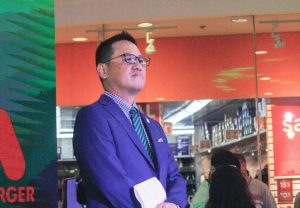MANILA, PHILIPPINES – Who says a burger can’t be turned Japanese? Adding in some Japanese zest to an American favorite, MOS Burgers is bringing in a new kind of sandwich in the Philippines, officially crossing the seas on February 26, 2020.
Established in Japan back in 1972, MOS stands for Mountain, Ocean, and Sun — to rise as high as the mountain, to have a heart as vast as the ocean and to be passionate with the warmth of the sun. The popular chain has more than 300 stores outside of Japan and is now expanding into the Philippines.
MOS Burger prides itself on its after order system which guarantees great quality burgers, packed with flavor in each bite. MOS Burger Philippines President Masahide Araki said that even though the brand was born and raised in Japan, they are now bringing it to Manila because Filipinos love the distinct taste of Japanese cuisine.
Ishoku Dougen
One of the philosophies behind the Japanese food chain is the belief that food and medicine are of the same origin, and the same somewhat stays true in their burgers as the meals are not just indulgent but light on the stomach too.
Among their most popular burgers are the MOS Cheese Burger and the Yakiniku Rice Burger, which were made available for two days in a pop-up store in Robinsons Galleria on January 15 and 16.
The signature MOS Cheese Burger is a mixture of light pork and beef sandwiched in soft buns, it comes with a twist brought by a tomato-based sauce; while the Yakiniku Rice Burger is a reconstruction of the yakiniku rice bowl with the glazed beef in between sheets of lettuce and rice bun instead of bread.
It is also worth noting that the teriyaki burger which is widely offered by different burger chains was first popularized by MOS in the 1990s.

“We know that the Filipino loves Japanese food as the restaurants of Mr. Young can attest. We hope that you could welcome and give the same love to MOS Burger,” said Tateishi Hiroshi, Vice President of MOS Burger Philippines. The company is a joint venture between Tokyo Coffee Holdings and MOS Food Services, Inc. of Japan Entrepreneur Hubert Young of Tokyo Coffee Holdings which has brought Coco Ichibanya, ramen shop Mitsuyado Sei-men, and bakery shop Yamato to the Philippines.
The Robinsons Galleria branch will open on February 26 and will be followed by an opening of MOS Cafe in Robinsons Place Manila and Robinsons Magnolia. There will also be stores in SM Megamall and O Square Greenhills.











